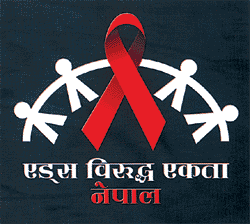 We hear the endless jingles on radio, see the celebrities on television, and watch them watch us from huge billboards. The message everywhere is: "Let's talk about HIV/AIDS".
We hear the endless jingles on radio, see the celebrities on television, and watch them watch us from huge billboards. The message everywhere is: "Let's talk about HIV/AIDS".
The campaign is aimed at raising awareness among Nepalis about the serious threat of HIV/AIDS which is going to be the main cause of death in the 15-49 age bracket over the next ten years. AIDS in Nepal has now been upgraded to a "concentrated epidemic", which means that any one, not just the vulnerable groups, may be at risk. 
But the word on the street is that the advertising blitz may have made "condom" a household word, but it hasn't made much of a dent in behaviour and attitude. And even if it has, it isn't worth the estimated Rs 30 million that has been spent on the ad campaign.
"We have been hearing similar messages over the last 15 years. But where is the change in the behaviour, especially among the youth?" asks Rajiv Kafle, a HIV positive activist who feels social perceptions haven't evolved. Kafle's cynicism is supported by a UNICEF-sponsored survey conducted last year. Of the 1,400 young people surveyed in seven districts, 92 percent had heard about HIV/AIDS, but only 72 percent knew condoms were a preventive measure, and fewer actually used them.
In 1999, Family Health International (FHI) found that only 70 percent of truckers along tarai highways used condoms. Nearly 11 percent of them had sexual infections, and 1.5 percent were HIV positive. The figure for injecting drug users in Kathmandu is even more frightening: nearly half of them were HIV positive and 18 percent of the sex workers in the valley were infected.
Critics say the anti-AIDS programme is largely-donor driven, and the problem is one of ownership. Donors want government to take the lead, but in practice they are reluctant to relinquish control. Aside from the strong commitment shown by the previous health minister, the political will has been weak.
The Health Ministry depends on donors for nearly half its financing, and is led by donor priorities which, globally, is AIDS. "There is a double-standard among donors between what they preach and practice," says Raghav Raj Regmi, a development analyst. Critics also see a mis-match between the lavish funding for HIV/AIDS and for less-glamourous diseases like TB, malaria and water-borne infections.  There are also questions of cost-effectivity. A consortium of multi- and bilateral donors (UNAIDS, UNDP, USAID, DfID, AusAid), with FHI as executing partner, launched the "Nepal Initiative" program in collaboration with the Nepal Centre for AIDS and STD Control (NCASC) two years ago.
There are also questions of cost-effectivity. A consortium of multi- and bilateral donors (UNAIDS, UNDP, USAID, DfID, AusAid), with FHI as executing partner, launched the "Nepal Initiative" program in collaboration with the Nepal Centre for AIDS and STD Control (NCASC) two years ago.
It will address the urgent needs of sex workers, their clients, and injecting drug users. The activities focus on social marketing of condoms, drug counselling, HIV care and support, voluntary HIV testing and counselling.
Experts like Shyam Sunder Mishra, acting director at NCASC, admit that there isn't enough supervision and monitoring of how the money is spent. "There is virtually no coordination at the managerial level among the NGOs working in the community," he told us.
When approached, FHI refused comment, saying only: "An impact assessment study is going on and FHI is in no position to tell anything to the press at the moment."
Michael O'Dwyer, senior health and population adviser at the British aid agency DfID that has poured ?1.6 million into the Nepal Initiative, told us: "The Nepali people have the right to know where this money is going, and we accept that implementation must be carried out by Nepalis using Nepali resources."
At UNAIDS, the body that is supposed to coordinate UN programmes in HIV/AIDS, country director Michael Hahn felt the message in the media campaign may be too narrow. "They are focussing on specific behaviour issues, what is missing is the access to services."
Rajiv Kafle agrees: "Every drug user knows syringes shouldn't be shared. But the support services aren't there to allow him to play safe." What is worrying many health planners is that the insurgency has increased poverty, unemployment and migration, all of which contribute to the spread of HIV through commercial sex, population mobility and injecting drug use among youth.
The first line of defence against HIV/AIDS is public awareness, and hence the extensive ad campaign. But the big question is: when is information cost-effective, and is awareness enough?


